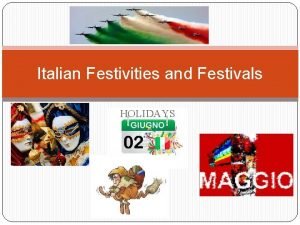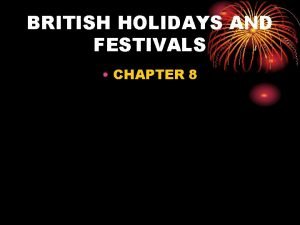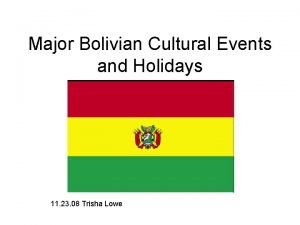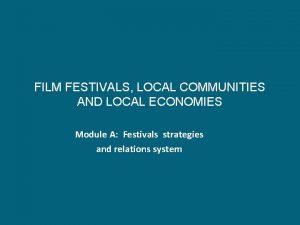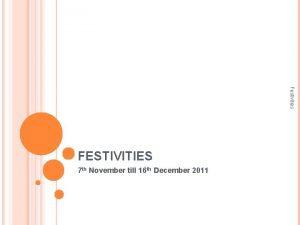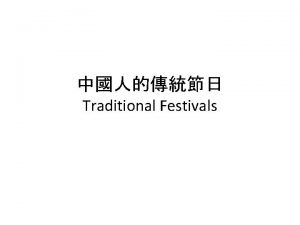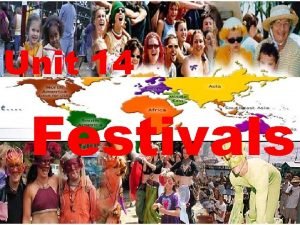Italian Festivities and Festivals HOLIDAYS INTRODUCTION Italian holidays






- Slides: 6

Italian Festivities and Festivals HOLIDAYS

INTRODUCTION Italian holidays, festivals, and feast days reflect Italian culture, history, and religious practices. Some Italian holidays are similar to those celebrated throughout many other parts of the world, while others are unique to Italy. January 1, for example, is Capodanno (New Year's Day), while April 25 is the Festa della Liberazione (Liberation Day), an annual national holiday commemorating the 1945 liberation ending World War II in Italy. Other Italian holidays include November 1, Ognissanti (All Saints Day), a religious holiday during which Italians typically bring flowers to the graves of their deceased relatives, and Pasquetta (Easter Monday), when traditionally, Italians fare una scampagnata (to go for an outing) in the countryside and have a picnic to mark the beginning of springtime.

In addition to national holidays (when government offices and most businesses and retail shops are closed), many Italian towns and villages celebrate the feast day of their Santo Patrono (patron saint), which differs from place to place. Keep in mind, too, when consulting an Italian calendar, that when a religious festival or holiday falls on a Tuesday or Thursday, Italians oftentimes fare il ponte (literally, to make a bridge), or make a four-day holiday, by taking off the intervening Monday or Friday.

Holidays, Festivals and Feast Days January 1: Capodanno (New Year's Day) 6: Epifania/La Befana (Epiphany) 7: Giornata Nazionale della Bandiera (Flag Day)—celebrated principally in Reggio nell'Emilia February 14: Festa degli Innamorati (St Valentine’s Day) Movable: Martedì Grasso (Mardi Gras / Fat Tuesday)—part of Carnevale Movable: Mercoledì di Ceneri (Ash Wednesday) March 8: La Festa della Donna (Women’s Day 19: Festa del Papà (San Giuseppe) Father’s Day Movable (can also occur in April): Domenica delle Palme (Palm Sunday) Movable (can also occur in April): Venerdì Santo (Good Friday) Movable (can also occur in April): Easter (Easter Sunday) Monday after Easter (can also occur in April): Pasquetta, Lunedì di Pasqua (Easter Monday) April 1: Pesce d’Aprile (April Fool's Day) 25: Festa della Liberazione (Liberation Day)

• May • • • 1: Festa del Lavoro (May Day) June 2: Festa della Repubblica (Republic Day) 29: San Pietro and San Paolo (Patron Saints of Roma) August 15: Ferragosto / Assunzione (Day of the Assumption) October 4: San Francesco (Patron Saint of Italia) November 1: Ognissanti (All Saints Day) 2: Il Giorno dei Morti (Day of the Dead) December 8: Immacolata Concezione (Immaculate Conception) 25: Natale (Christmas) 26: Santo Stefano (St. Stephen's Day) 31: San Silvestro (St. Silvester's Day)

Buon Natale! Merry Christmas Green, white, and red—the colors of Italy's national flag, and the traditional Christmas colors as well. It may not be a surprise, then, that Christmas probably originated in Italy One widely held theory is that the holiday was an intentional christianization of Saturnalia and other pagan festivals. In A. D. 274, Emperor Aurelian decreed December 25—the solstice on the Julian calendar—as natalis solis invicti ("birth of the invincible sun"), a festival honoring the sun god Mithra In modern-day Italy, the celebration of Christmas has its own unique flavor, combining pastoral traditions, traditional cultural rites, influences from Northern Europe, and a strong spiritual context to mark the important event.
